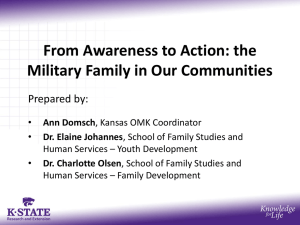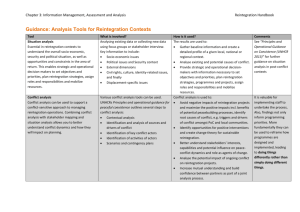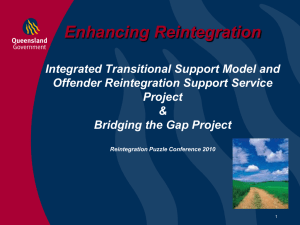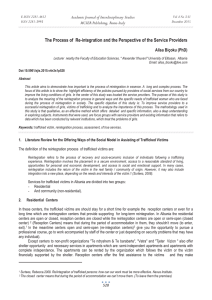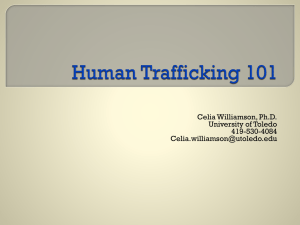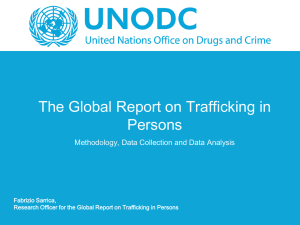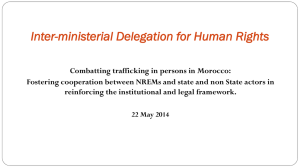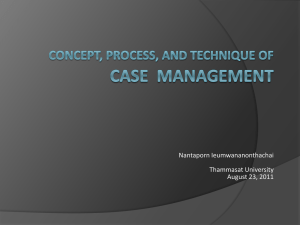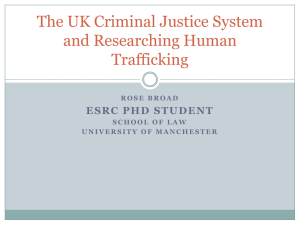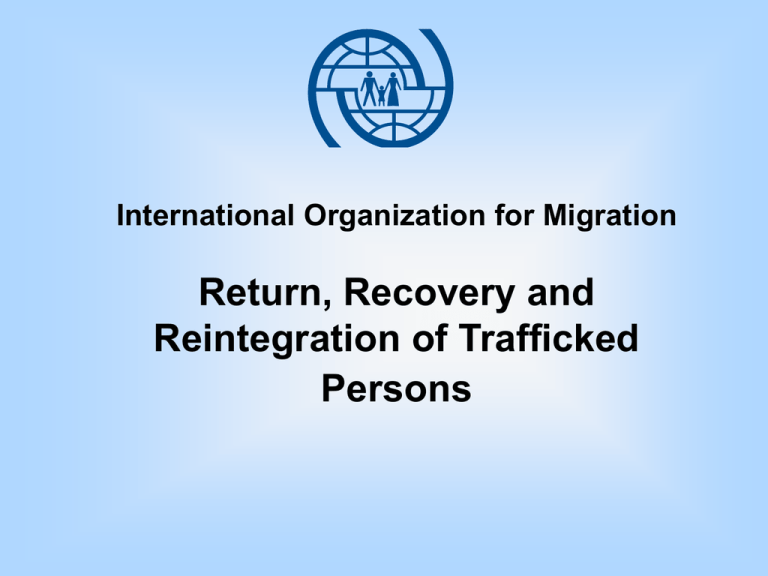
International Organization for Migration
Return, Recovery and
Reintegration of Trafficked
Persons
Return, Recovery and Reintegration Fundamentals
Trafficking is complex and occurs in a variety of ways
Regardless of circumstances, there are fundamental
aspects of any return, recovery and reintegration
process
Any assistance provided must be assessed in terms of
whether it promotes and provides protection for the
human rights of the victim.
Human Rights Framework
within the Trafficking Protocol
• Article 2: “to protect and assist the victims of
such trafficking with full respect for their
human rights.”
• Article 6: States have an obligation to provide
assistance to victims of trafficking (including
appropriate housing; counseling and
information; medical, psychological and
material assistance; and employment,
educational and training opportunities)
Return, Recovery, and Reintegration Fundamentals
Empowering the Individual
INFORMED CONSENT—victims must be
informed at every step of the process of
their human and as well as civil rights
(including their right to decline
assistance).
Right to Self Determination
Step 1: Victim identification
Objective: To identify migrants who have been exploited
as victims of trafficking so that appropriate response
measures can be taken—both legal and social
Example: Removal of victims of trafficking from
confinement or detention to specialized safe houses or
shelters.
A VICTIM CENTERED APPROACH
Step 2: Shelter and recovery
Objective: To provide safe accommodation and comprehensive
medical and social support for individuals identified as victims
of trafficking
Shelters should provide:
•
Food
•
Accommodation
•
Basic medical care,
•
Access to comprehensive medical and psychosocial care or
other social services
•
If appropriate, access to STD/STI testing and treatment
(not forced testing)
Step 2: Shelter and recovery
Referral system for physical or psychological care
beyond the shelter’s capabilities
Appropriate security measures (during stay and
transfer)
Information about the case and the victim gathered in
a confidential and non-threatening manner
Step 3: Return
Objective: To ensure safe and secure voluntary travel of
the trafficking victim from the shelter or safe-house to
appropriate place of residence
Step 3: Return
• Facilitated voluntary return – not forced
deportation
• Documentation / establishing identity
• Security arrangements and escorts
• Transport arrangements
• Transit and reception arrangements
• Travel documentation / visa arrangements
• Safe and dignified
Step 4: Reintegration
Objective: To facilitate the successful social integration of
the victim into her/his family (where appropriate) and
society
Examples:
• Family tracing and assessment
• Psychosocial assistance
• Social welfare assistance
• Vocational training
• Peer-to-peer support
• Non-formal education
• Legal assistance
Step 4: Reintegration
Reintegration ≠ Return
Preventing re-trafficking
Reintegration begins prior to return
Developing links with service providers in
the home country / community
Successful Return, Recovery and Reintegration is based on:
•
•
•
•
•
•
•
•
•
•
•
Complete Case Reports
Plans that are based on individuals themselves—self determination
Protection of Victims at destination areas
Family Tracing
Family Assessment
Decision making on return – to family or alternative options
Processing Travel Documents
Turn-over and reception process
Reintegration support
Monitoring and follow-up on reintegration
A human rights centered approach
Challenges with Reintegration
•
•
•
•
•
•
•
•
•
•
Initial factors still present re-victimization
Few opportunities for self-sustainable living
Few options for support after reintegration
Very few agencies provide interventions to both the children and
families
No activities to increase income-generating capacity of families
Systematic challenges with reintegration interventions:
Lack of follow up support after reintegration
No market is available for the skills after training
Profit made too small to live on due to lack of market networks
Lack of easy access to health services although health issue is
critical
An effective response requires
multidisciplinary cooperation
Return, Recovery and Reintegration systems
Guiding Principles – Safety, Security, and a Human
Rights based approach
Informed consent
Right to Privacy
Self-determination
“Voluntariness”
Indonesia (March 05-Nov 05)
Sex of Victim
Frequency
Percent
Male
79
17
Female
399
83
Total
478
100
Indonesia (March 05-Nov 05)
Age of VOT
Frequency
Percentage
Adult
370
77
Children
105
22
Infant
3
1
Total
478
100
Indonesia (March 05-Nov 05)
Kind of Job
Frequency
Percentage
Maid
355
74
Sex worker
50
11
Plantation worker
39
8
Construction
3
.6
Beggar
2
.4
Restaurant
1
.2
Fishing platform
3
.6
Other
25
5
Total
478
100
Number of Trafficking Victims Assisted Under
Mekong Regional Return & Reintegration Project
(as of November 2005)
Phase I
(Sept 2000-Feb 2004)
Phase II
(Feb 2004-Nov 17, 2005;
Ph II ends in Aug 2007)
Cambodia
488
157
Laos
212
206
Myanmar
150
69
Vietnam
31
4
China
(Yunnan
Province)
4
7
Total
885
443
Grand Total
1,328
FACES OF VICTIMS OF
TRAFFICKING

